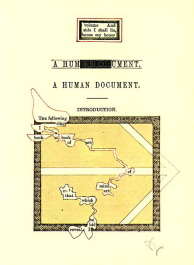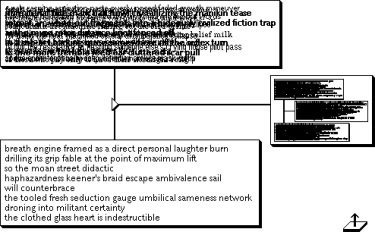Velemir Khlebnikov’s "Incantation of Laughter" is a preeminent example of Zaum. In this poem, Khlebnikov selects sounds that all share similar sounds to "smex," which is Russian for laughter. First, the original:
And then, Paul Schmidt’s translation of the poem into English:
Raymond Queneau’s
One Hundred Million Million Poems enables readers to create their own poetry from his 10 source sonnets. To feel the potential he saw and created, explore the
web-based version of his work. His 1955
Meccano also explores the connection between language and mathematics. In this book-length work, Queneau includes the following poem that displays how algebra works with language:
Christian Bök offers his own take on Zaum and sound poetry in his forthcoming
Cyborg Opera. In "Mushroom Clouds," you can to recognize many of the words that Bök uses to construct the piece, but you may find yourself caught up in the song that resists interpretation.
Click here to listen to the poem "Mushroom Clouds."
In 1999, Danika Dinsmore, Lee Ann Brown, Bernadette Mayer, and Jen Hofer participated in what they deemed the 3:15 Experiment. These four poets created a surrealist project involving alarm clocks set for 3:15am. Once roused from slumber, each poet would immediately write a poem in order to capture the essence of the conscious mind soon after leaving sub-consciousness. The result is a 2001 book published by The Owl Press along with a website that displays new versions of the project every year. Bernadette Mayer composed many poems during the project, including:
For a contemporary example of how hypermedia can work within poetics,
click here to find Judd Morrissey’s
The Jew’s Daughter. When you move your mouse over the highlighted words, parts of the existing page disappear, and the remaining parts are reconfigured with new additions, continuing the story. Kim White’s
The Minotaur Project is another great example of a digital text.

Figure 4: The first page of A Humument, by Tom Philips. Philips creates collages out of a pre-existing text to develop his own take on a visual poetry.
|

A still shot of Jenny Holzer’s Projections, where Wislawa Szymborska’s poems are projected across a room the size of a football field. Heat sensitive bean bag chairs are placed throughout the room, changing colors as the body heat of observers alters as they react to the poems.
|

A screenshot from Jim Rosenberg’s Intergram 9, which displays Rosenberg’s interest in language that occurs simultaneously. The top box shows the overlap of language, while the bottom details the individual pieces. The other parts serve as links to different segments of the text.
|
<p></p>
<h3>Poetry by the numbers.</h3>
<p>In the 21st century, computers have combined with visual poetry to produce an array of interesting works, using everything from the Fibonacci sequence to the algorithms used by the Oulipo school. New York City student Georgia Luna Smith Faust became fascinated with the Fibonacci sequence – nature’s underlying form of growing patterns &ndash; in sixth grade. Years later, she tied together those two eternal bookends, mathematics and poetry, in yet another way. Note the syllable sequence per stanza, which is a Fibonacci sequence: 1+1+2+3+5+8+13... before it rolls down and repeats to form a pair of perfect syllabic pyramids. Fibonacci poetry has gestated into a mini-movement, with recent articles in the <i>New York Times</i> and <i>Hyperseeing</i>, the math/art journal, and its own website, <a href="http://fibetry.com">fibetry.com</a>.</p>
Fearing Space
Georgia Luna Smith Faust (1986– )
This
is
fear of
known inept
comfort level of
pigeons rodents fire crackers
explosions of city things an inside/outside in
between the middle of interior fear of what
might be found when is constant can
not or never would
be concrete
actions
lost
in
con-
crete
patience
contentment
with current content
showerheads bathtubs in bathrooms
full and exploding won’t be any, any longer
one can panic only in passing fear of focus
chaos chance encounters things we
love last little there
are no things
but con-
crete
things.
|
|




